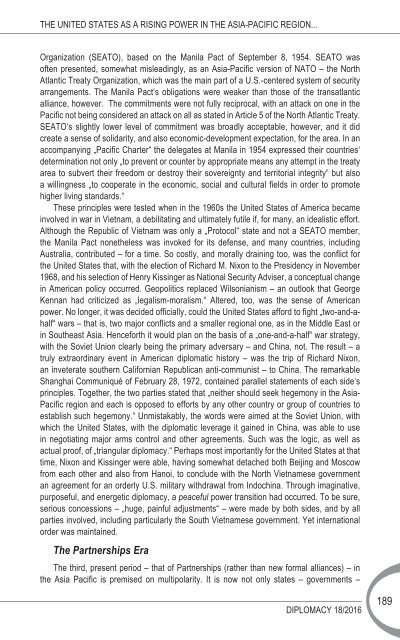DIPLOMACY ДИПЛОМАЦИЯ
2kGfdFv
2kGfdFv
Create successful ePaper yourself
Turn your PDF publications into a flip-book with our unique Google optimized e-Paper software.
THE UNITED STATES AS A RISING POWER IN THE ASIA-PACIFIC REGION...<br />
Organization (SEATO), based on the Manila Pact of September 8, 1954. SEATO was<br />
often presented, somewhat misleadingly, as an Asia-Pacific version of NATO – the North<br />
Atlantic Treaty Organization, which was the main part of a U.S.-centered system of security<br />
arrangements. The Manila Pact’s obligations were weaker than those of the transatlantic<br />
alliance, however. The commitments were not fully reciprocal, with an attack on one in the<br />
Pacific not being considered an attack on all as stated in Article 5 of the North Atlantic Treaty.<br />
SEATO’s slightly lower level of commitment was broadly acceptable, however, and it did<br />
create a sense of solidarity, and also economic-development expectation, for the area. In an<br />
accompanying “Pacific Charter” the delegates at Manila in 1954 expressed their countries’<br />
determination not only “to prevent or counter by appropriate means any attempt in the treaty<br />
area to subvert their freedom or destroy their sovereignty and territorial integrity” but also<br />
a willingness “to cooperate in the economic, social and cultural fields in order to promote<br />
higher living standards.”<br />
These principles were tested when in the 1960s the United States of America became<br />
involved in war in Vietnam, a debilitating and ultimately futile if, for many, an idealistic effort.<br />
Although the Republic of Vietnam was only a “Protocol” state and not a SEATO member,<br />
the Manila Pact nonetheless was invoked for its defense, and many countries, including<br />
Australia, contributed – for a time. So costly, and morally draining too, was the conflict for<br />
the United States that, with the election of Richard M. Nixon to the Presidency in November<br />
1968, and his selection of Henry Kissinger as National Security Adviser, a conceptual change<br />
in American policy occurred. Geopolitics replaced Wilsonianism – an outlook that George<br />
Kennan had criticized as “legalism-moralism.” Altered, too, was the sense of American<br />
power. No longer, it was decided officially, could the United States afford to fight “two-and-ahalf”<br />
wars – that is, two major conflicts and a smaller regional one, as in the Middle East or<br />
in Southeast Asia. Henceforth it would plan on the basis of a “one-and-a-half” war strategy,<br />
with the Soviet Union clearly being the primary adversary – and China, not. The result – a<br />
truly extraordinary event in American diplomatic history – was the trip of Richard Nixon,<br />
an inveterate southern Californian Republican anti-communist – to China. The remarkable<br />
Shanghai Communiqué of February 28, 1972, contained parallel statements of each side’s<br />
principles. Together, the two parties stated that “neither should seek hegemony in the Asia-<br />
Pacific region and each is opposed to efforts by any other country or group of countries to<br />
establish such hegemony.” Unmistakably, the words were aimed at the Soviet Union, with<br />
which the United States, with the diplomatic leverage it gained in China, was able to use<br />
in negotiating major arms control and other agreements. Such was the logic, as well as<br />
actual proof, of “triangular diplomacy.” Perhaps most importantly for the United States at that<br />
time, Nixon and Kissinger were able, having somewhat detached both Beijing and Moscow<br />
from each other and also from Hanoi, to conclude with the North Vietnamese government<br />
an agreement for an orderly U.S. military withdrawal from Indochina. Through imaginative,<br />
purposeful, and energetic diplomacy, a peaceful power transition had occurred. To be sure,<br />
serious concessions – “huge, painful adjustments” – were made by both sides, and by all<br />
parties involved, including particularly the South Vietnamese government. Yet international<br />
order was maintained.<br />
The Partnerships Era<br />
The third, present period – that of Partnerships (rather than new formal alliances) – in<br />
the Asia Pacific is premised on multipolarity. It is now not only states – governments –<br />
<strong>DIPLOMACY</strong> 18/2016<br />
189


